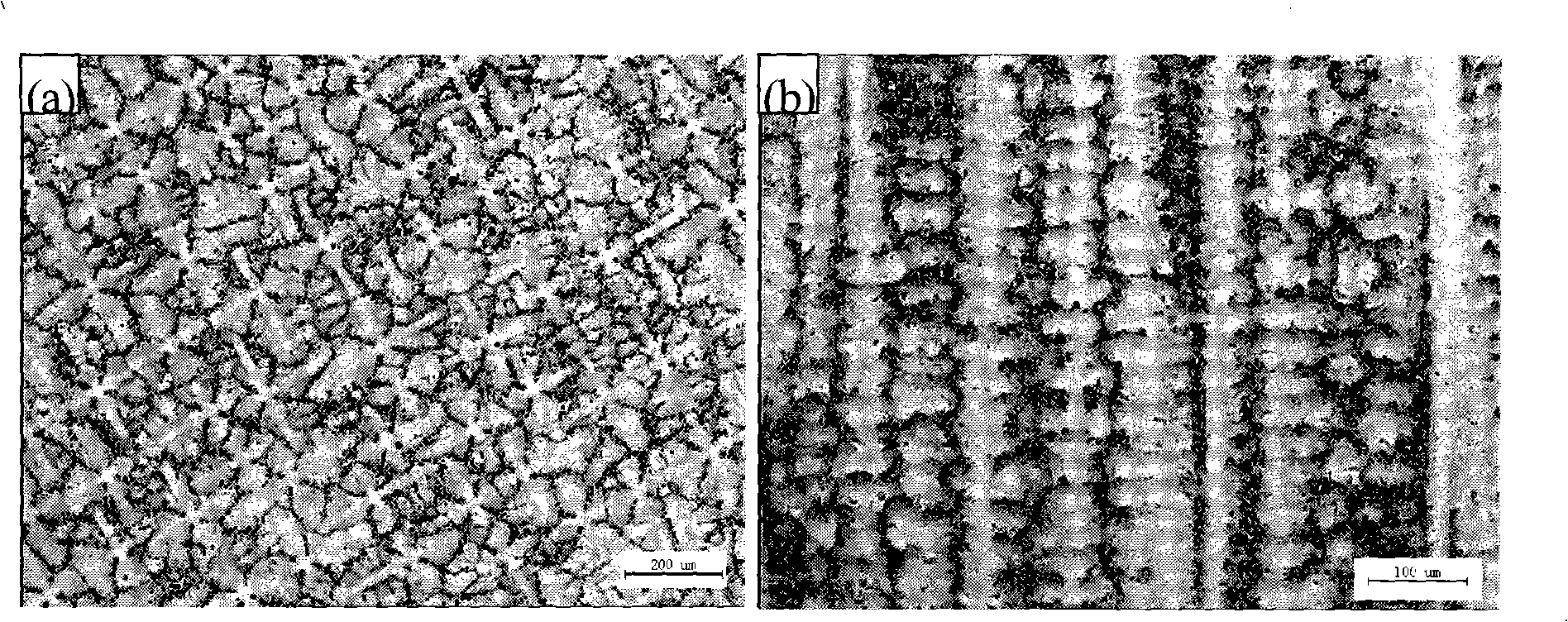Directional solidification heat corrosion resistant nickel base cast superalloy and preparation method thereof
A technology of directional solidification and superalloy, which is applied in the improvement field of casting superalloy, can solve the problems of high cost of alloy and cannot be applied to gas turbine turbine blades, etc., and achieves the effects of good parallelism, stable structure and excellent comprehensive performance.
- Summary
- Abstract
- Description
- Claims
- Application Information
AI Technical Summary
Problems solved by technology
Method used
Image
Examples
Embodiment 1
[0028] By weight percentage, the alloy composition is: C 0.07%; Cr 14.8; Co 9.5%; W 5.1%; Mo 1.8%; Al 3.1%; Ti 4.6%; Hf 0.46%; Ta 0.8%; B 0.08%; Y( Addition amount) 0.015%; Mn 0.18%; Si 0.18%; P 0.006%; S 0.007%; Fe 0.3%;
[0029] Alloy melting and casting: use a 25kg vacuum induction furnace to melt the master alloy, and use the liquid metal cooling (LMC) process for directional solidification, and the vacuum degree of the directional furnace is ≤5×10 -4 mmHg, pouring temperature 1540°C, drawing speed 10mm / min, temperature gradient 100°C / cm, liquid tin temperature 270°C.
[0030] Alloy heat treatment system: 1170°C, heat preservation 4h, air cooling +1050°C, heat preservation 4h, air cooling +850°C, heat preservation 16h, air cooling.
[0031] The main mechanical properties of the alloy:
[0032] Tensile properties at room temperature: σ b 1320MPa; σ 0.2 990MPa; δ8%; 4.0%.
[0033] Durability: 930℃, stress 270MPa, duration τ150.5h, δ20.8%.
[0034] The transverse and...
Embodiment 2
[0036] By weight percentage, the alloy composition is: C 0.045%; Cr 14.7; Co 9.2%; W 4.85%; Mo 1.72%; Al 2.85%; Hf 0.35%; Ti 4.35%; Ta 0.4%; B 0.07%; Y( Addition amount) 0.015%; Mn 0.12%; Si 0.10%; P 0.006%; S 0.005%; Fe 0.2%;
[0037] Alloy smelting and casting, using a 25kg vacuum induction furnace to melt the master alloy, and using the liquid metal cooling (LMC) process for directional solidification, the vacuum degree of the directional furnace is ≤5×10 -4 mmHg, pouring temperature 1520°C, drawing speed 8mm / min, temperature gradient 95°C / cm, liquid tin temperature 300°C.
[0038] The heat treatment system is: 1200°C, heat preservation 2h, air cooling +1090°C, heat preservation 2h, air cooling +850°C, heat preservation 24h, air cooling.
[0039] The main mechanical properties of the alloy:
[0040] Tensile properties at room temperature: σ b 1330MPa; σ 0.2 1040MPa; δ8.0%; 9.5%.
[0041] Durability performance: 930℃, stress 270MPa, τ117.3h.
Embodiment 3
[0043]In terms of weight percentage, the alloy composition is: C 0.08%; Cr 15.3%; Co 9.9%; W 5.7%; Mo2.2%; Al 3.2%; Ti 4.9%; Hf 0.55%; Ta 1.3%; B 0.09%; Y (addition amount) 0.015%; Mn 0.19%; Si 0.18%; P 0.007%; S 0.008%; Fe 0.4%;
[0044] Alloy melting and casting: use a 25kg vacuum induction furnace to melt the master alloy, and use the liquid metal cooling (LMC) process for directional solidification, and the vacuum degree of the directional furnace is ≤5×10 -4 mmHg, pouring temperature 1500°C, drawing speed 12mm / min, temperature gradient 110°C / cm, liquid tin temperature 270°C.
[0045] Alloy heat treatment system: 1170°C, heat preservation 4h, air cooling +1050°C, heat preservation 4h, air cooling +850°C, heat preservation 16h, air cooling.
[0046] Tensile properties at room temperature: σ b 1340MPa; σ 0.2 1110MPa; δ5.5%; 7.5%.
[0047] Durability performance: 930℃, stress 270MPa, τ124.8h.
PUM
| Property | Measurement | Unit |
|---|---|---|
| Stress | aaaaa | aaaaa |
Abstract
Description
Claims
Application Information
 Login to View More
Login to View More - R&D Engineer
- R&D Manager
- IP Professional
- Industry Leading Data Capabilities
- Powerful AI technology
- Patent DNA Extraction
Browse by: Latest US Patents, China's latest patents, Technical Efficacy Thesaurus, Application Domain, Technology Topic, Popular Technical Reports.
© 2024 PatSnap. All rights reserved.Legal|Privacy policy|Modern Slavery Act Transparency Statement|Sitemap|About US| Contact US: help@patsnap.com










